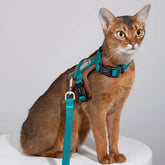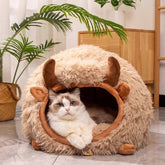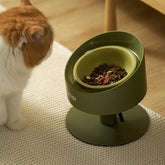How to tell if your cat is really happy

Cats are known for their independent and aloof nature, which can make it difficult to understand their emotions. However, as pet owners, it's important to pay attention to our cat's happiness and well-being. Understanding our cat's happiness not only helps us build a stronger bond with them, but also helps us identify and address any issues that may be affecting their mental and physical health. In this blog, we'll explore the different ways cats communicate their emotions and how to tell if your cat is really happy.
Physical Signs of a Happy Cat
Cats use their bodies to express their emotions, and understanding their physical cues can give us insight into their happiness. Here are some of the most common physical signs of a happy cat:
The tail position and movement
A cat's tail is a great indicator of its mood. When a cat is happy, their tail is relaxed and may even have a slight curve at the end. They may also wrap their tail around their body or twitch it slightly when they're feeling content.
The position of the ears
A happy cat's ears will be upright, but relaxed. They may also move their ears to track sounds and movements in their environment.
The appearance of the eyes
A happy cat's eyes will be bright and clear, with dilated pupils. They may also blink slowly, which is a sign of trust and relaxation.
Other physical cues
A happy cat will have a relaxed body posture, with their paws tucked under their body or stretched out in front of them. They may also knead their paws or rub their head against you or objects in their environment.

In addition to these common physical cues, it's important to note that some cats may display slightly different behaviors depending on their individual personality and breed. For example, some breeds, such as the Siamese, may have more vocal and active body language, while others, like the Persian, may have more subdued and relaxed body language.
As a cat owner, it's important to observe your own cat's behavior and note any deviations from their normal behavior. If you notice any sudden changes in their physical cues, it may be an indication of an underlying health issue, and it's important to consult with a veterinarian.
Overall, understanding your cat's physical cues can help you better understand its mood and emotional state. It can also help you identify when your cat may be feeling stressed or anxious, and take steps to alleviate those feelings.
Behavioral Signs of a Happy Cat
In addition to their physical cues, cats also communicate their emotions through their behavior. Here are some of the most common behavioral signs of a happy cat:
Playfulness and energy levels
A happy cat will be playful and active, with bursts of energy throughout the day. They may chase toys, run around the house, or engage in other forms of play.
Appetite and grooming habits
A happy cat will have a healthy appetite and will regularly groom themselves. They may also groom other cats in their environment as a sign of affection.
Social interactions
A happy cat will seek out social interactions with their owners and other cats. They may rub against you or other cats, follow you around the house, or curl up on your lap for cuddles.
Litter box habits
A happy cat will use the litter box regularly and without hesitation. They will also cover their waste, which is a sign of cleanliness and respect for their environment.

Understanding Your Cat's Individual Needs
It's important to remember that every cat is unique and may have different needs and preferences when it comes to their happiness. Here are some tips for understanding your cat's individual needs:
Different cats have different personalities
Some cats are more social and outgoing, while others are more independent and reserved. Understanding your cat's personality can help you create an environment that promotes their happiness.
Identifying what makes your cat happy
Pay attention to your cat's behavior and body language to identify what makes them happy. Do they enjoy playing with certain toys? Do they prefer a quiet environment or one with lots of activity?
Creating an environment that promotes happiness
Once you understand your cat's individual needs, you can create an environment that promotes their happiness. This may include providing them with a comfortable sleeping area, offering a variety of toys and scratching posts, and spending quality time with them each day.

Vocalizations of a Happy Cat
Cats are known for their distinctive vocalizations, and understanding what they mean is an important part of understanding your cat's happiness. Here are some common types of vocalizations and what they might mean:
Meowing
Meowing is one of the most common vocalizations cats make, and it can mean a variety of things depending on the context. For example, a cat might meow to get your attention, ask for food or water, or let you know they're feeling lonely or anxious. Pay attention to the tone and frequency of your cat's meows to determine what they might be trying to communicate.
Chirping
Chirping is a unique vocalization that some cats make when they're excited or happy. It's often accompanied by a wagging tail and can be a sign that your cat is feeling playful or curious.
Trilling
Trilling is a type of purring that cats make when they're happy and relaxed. It's often accompanied by kneading or nuzzling and is a sign that your cat is feeling content and comfortable.
Hissing
Hissing indicates that your cat feels threatened or scared. It's a sign that your cat is trying to protect themselves and should be taken seriously.
Purring
Purring is one of the most well-known vocalizations cats make, and it's often associated with contentment and happiness. However, cats can also purr when they're nervous, anxious, or in pain. Pay attention to your cat's body language and behavior to determine what their purring might mean.

Understanding Your Cat's Individual Needs
Every cat is unique, and what makes one cat happy might not work for another. It's important to pay attention to your cat's individual needs and preferences to ensure that they're happy and healthy. Here are some tips for identifying what makes your cat happy:
Different cats have different personalities
Just like people, cats have unique personalities that influence their behavior and preferences. Some cats are social and outgoing, while others are more reserved and independent. Pay attention to your cat's personality to determine what they might need to be happy and comfortable.
Identifying what makes your cat happy
Observing your cat's behavior and preferences can give you valuable insights into what makes them happy. For example, does your cat enjoy playing with toys or snuggling up in a cozy bed? Do they prefer certain types of food or treats? Pay attention to these preferences and try to provide your cat with what they need to be happy and comfortable.
Creating an environment that promotes happiness
Creating an environment that promotes your cat's happiness and well-being is key to ensuring that they're happy and healthy. This might include providing plenty of toys and play opportunities, creating cozy sleeping spaces, and ensuring that your cat has access to clean water and nutritious food. It's also important to create a safe and secure environment that allows your cat to feel comfortable and relaxed.

Conclusion
Understanding your cat's happiness and well-being is essential for pet owners. Cats use their bodies, behavior, and vocalizations to express their emotions. Every cat is unique and may have different needs and preferences for their happiness. As a pet owner, it's important to observe your cat's behavior and note any deviations from their normal behavior, as it may indicate underlying health issues. By understanding your cat's individual needs and creating an environment that promotes their happiness, you can build a strong bond with your feline friend and ensure their overall well-being.























